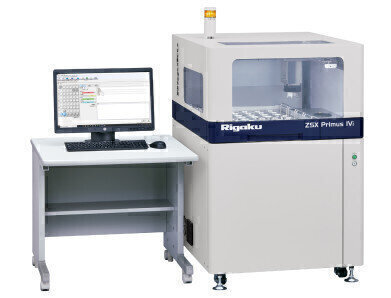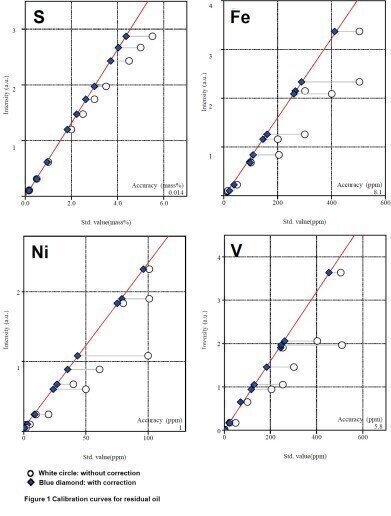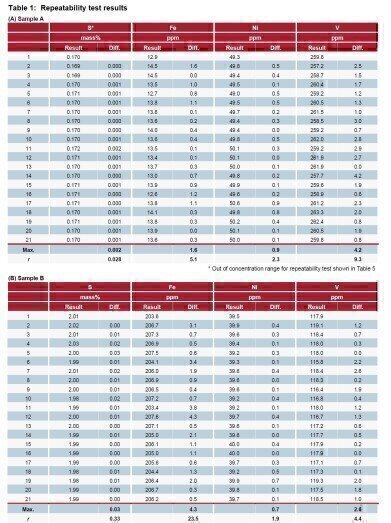-

-
 Figure 1
Figure 1 -
 Table 1
Table 1
Analytical Instrumentation
Analysis of S, Fe, Ni and V in Residual Oil According to IP610/13
Nov 17 2020
Introduction
Residual oil, which contains sulphur (S), iron (Fe), nickel (Ni), vanadium (V) and other elements, is obtained after distilling crude oil. It is used for marine fuel or electric power plant fuel. When residual oil is burned, some elements can cause damage to marine engines and the environment. For example, sulphur is considered the most harmful element causing air pollution, and metals like Ni, V and Fe are regarded as catalyst poisons, blocking a catalyst’s performance.
X-ray fluorescence (XRF) is a powerful tool for analysing these elements in residual oil. Sample preparation is very simple and analysis results are obtained quickly. This application report describes the analysis of S, Fe, Ni and V by IP Test Method 610/13 - Determination of sulphur, vanadium, nickel, iron, calcium, zinc and phosphorous in residual fuel oil by wavelength dispersive X-ray fluorescence spectrometry – and demonstrates the performance of the Rigaku ZSX Primus IVi sequential wavelength dispersive X-ray fluorescence (WDXRF) spectrometer.
Instrument
The ZSX Primus IVi tube-below WDXRF spectrometer is optimised for the routine analyses that today’s petroleum laboratories need to perform. The optical chamber can be maintained under vacuum while the sample chamber is under helium atmosphere by using a vacuum seal between the optical chamber and the sample chamber. The vacuum seal minimises helium gas consumption and reduces the time required for helium purge. The spectrometer is equipped with a 4 kW X-ray tube with an ultra-thin beryllium window or a 3 kW X-ray tube.
The operation software is designed for easy routine analysis. The quantitative analysis flow-bar guides users step by step to generate applications. The sample ID table and program operation help operators carry out daily analysis.
Sample and sample preparation
Residual oil standard samples supplied by Analytical Services, Inc. were used for calibration.
Eight grams of each residual oil sample was poured into a liquid cell (Chemplex® 1095). 3.6 μm thick Mylar® (Chemplex® 150) was used as the sample film.
Measurement and calibration
Measurements were performed on the ZSX Primus IVi spectrometer with a high-performance 4 kW Rh-target X-ray tube for S, Fe, Ni and V. Primary beam filters were used to protect the X-ray tube window in case of sample leakage. In addition, the filter reduces the background to improve the peak-to-background ratio.
The calibration curves were generated with a matrix correction applied to all the analytes. The correction coefficients used were calculated theoretically by the fundamental parameter (FP) method. The calibration curves are shown in Figure 1.
Analysis results
Typical lower limits of detection (LLD) for Fe, Ni and V calculated using the standard sample with the lowest content.
Repeatability tests for two samples (sample A and B) were carried out for 21 test portions according to “method A” of IP610-13. The test results are tabulated in Table 1, in which the differences between two successive aliquots are shown and “r” represents “repeatability” as defined in IP 610/13, which states that the difference between two successive test results obtained by the same operator with the same apparatus under constant operation conditions on identical test material would, in the normal and correct operation of the test method, exceed the value for repeatability defined in IP 610/13 METHOD A.
The test results shown in Table 1, where the difference between two successive aliquots does not exceed the repeatability (r) for each analyte, prove that the performance of the ZSX Primus IVi spectrometer meets the requirement of ISO610-13 for S, Fe, Ni and V analysis.
Digital Edition
PIN 25.1 Feb/March
March 2024
In This Edition Safety - The technology behind the ION Science Tiger XT - Safety with ammonia and LOHCs as hydrogen carriers Analytical Instrumentation - Discussion on new tribology te...
View all digital editions
Events
Apr 28 2024 Montreal, Quebec, Canada
Apr 30 2024 Birmingham, UK
May 03 2024 Seoul, South Korea
May 05 2024 Seville, Spain
May 06 2024 Riyadh, Saudi Arabia

















